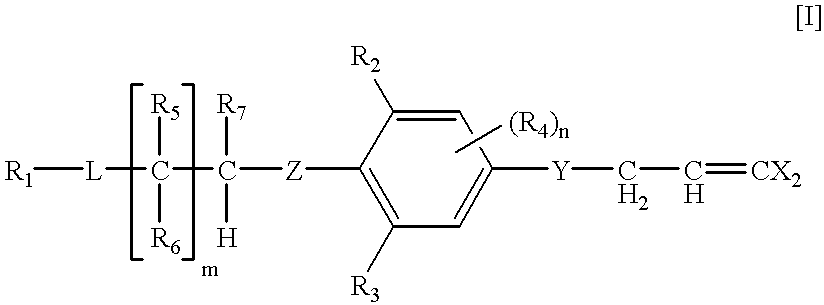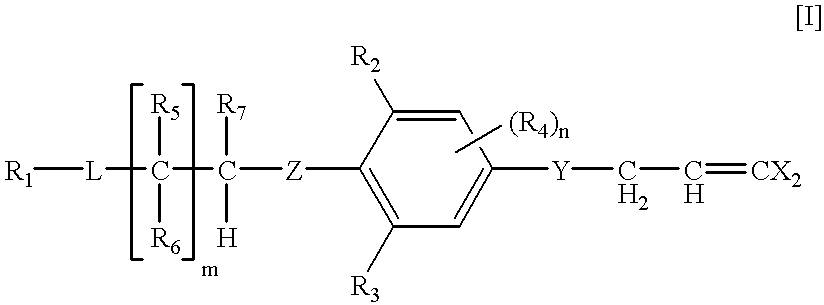Dihalopropene compounds insecticides containing them as active ingredients, and intermediates for their production
a technology of dihalopropene compounds and insecticides, which is applied in the field of dihalopropene compounds, can solve the problems that cannot always be said that these compounds are satisfactorily effective, and achieve the effect of satisfactory insecticidal activity and excellent insecticidal activity
- Summary
- Abstract
- Description
- Claims
- Application Information
AI Technical Summary
Benefits of technology
Problems solved by technology
Method used
Image
Examples
production example 9
Production of Compound (59) by Production Process A
To a mixture of 0.66 g of 3-ethyl-5-methyl-4-(3-(4-(trifluoromethyl)benzamido)propyloxy)phenol, 0.29 g of potassium carbonate and 20 ml of N,N-dimethylformamide was added dropwise a mixed solution of 0.28 g of 1,1,3-trichloropropene and 5 ml of N,N-dimethylformamide, while stirring at room temperature. After stirring at room temperature for 6 hours, the reaction mixture was poured into ice water and extracted twice with 50 ml of diethyl ether. The ether layers were combined, washed with water, dried over anhydrous magnesium sulfate, and then concentrated to give crude crystals. The crude crystals were ground and washed with n-hexane, which afforded 0.48 g of 3-ethyl-5-methyl-1-(3,3-dichloro-2-propenyloxy)-4-(3-(4-(trifluoromethyl)benzamido)propyloxy)benzene (58% yield), m.p., 92.2.degree. C.
production example 10
Production of Compound (67) by Production Process F
To a mixture of 0.96 g of 4-(3-aminopropyloxy)-3,5-dichloro-1-(3,3-dichloro-2-propenyloxy)benzene, 0.53 g of 5-(trifluoromethyl)-2-pyridinecarboxylic acid, 0.37 g of triethylamine and 10 ml of chloroform was added 0.64 g of WSC hydrochloride, while stirring at room temperature. After stirring at room temperature for 6 hours, the reaction mixture was concentrated to give a residue. The residue was subjected to silica gel chromatography, which afforded 0.15 g of 3,5-dichloro-1-(3,3-dichloro-2-propenyloxy)-4-(3-(5-(trifluoromethyl)picolinamido)propoxy)benzene (10% yield), m.p., 55.1.degree. C.
production example 11
Production of Compound (34) by Production Process F
To a mixture of 0.35 g of 4-(3-aminopropyloxy)-3,5-dichloro-1-(3,3-dichloro-2-propenyloxy)benzene, 0.19 g of 5-bromo-2-furancarboxylic acid, 0.18 ml of triethylamine and 10 ml of chloroform was added 0.23 g of WSC hydrochloride, while stirring at room temperature. After stirring at room temperature for 6 hours, the reaction mixture was concentrated to give a residue. The residue was dissolved in 50 ml of ethyl acetate, and the ethyl acetate layer was successively washed with 10% hydrochloric acid, saturated aqueous sodium hydrogen carbonate solution and saturated saline solution, dried over anhydrous magnesium sulfate, and then concentrated to give a residue. The residue was subjected to silica gel chromatography, which afforded 0.35 g of 3,5-dichloro-1-(3,3-dichloro-2-propenyloxy)-4-(3-(5-bromo-2-furancarboxamido)propyloxy)-benzene (64% yield), n.sub.D.sup.24.0 1.5918.
PUM
| Property | Measurement | Unit |
|---|---|---|
| boiling point | aaaaa | aaaaa |
| boiling point | aaaaa | aaaaa |
| temperature | aaaaa | aaaaa |
Abstract
Description
Claims
Application Information
 Login to View More
Login to View More - R&D
- Intellectual Property
- Life Sciences
- Materials
- Tech Scout
- Unparalleled Data Quality
- Higher Quality Content
- 60% Fewer Hallucinations
Browse by: Latest US Patents, China's latest patents, Technical Efficacy Thesaurus, Application Domain, Technology Topic, Popular Technical Reports.
© 2025 PatSnap. All rights reserved.Legal|Privacy policy|Modern Slavery Act Transparency Statement|Sitemap|About US| Contact US: help@patsnap.com



